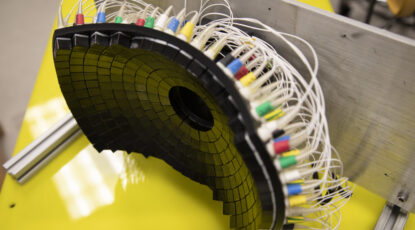-
These bubbles kill cancer
“Histotripsy” is a technique created by U-M engineers and doctors that harnesses soundwaves to attack cancer. It comes with the promise of few, if any side effects, a quick treatment time and, for patient Carrie Kumpel, the hope that it would completely destroy three spots that had formed on her liver.
-
Hungry for more: Cancer, metabolism, and food
Metabolism pathways make tumors sensitive or resistant to treatments. A collaborative group of U-M scientists is leveraging these avenues to explore the growing foundation of new potential therapies.
-
Tumor-destroying sound waves receive FDA approval for liver treatment in humans
Technique developed at U-M provides a noninvasive alternative to surgery, chemotherapy, and radiation treatments for cancer. A human trial underway since 2021 at the Rogel Cancer Center and other locations demonstrates the technology’s ability to meet the testing’s primary effectiveness and safety targets.
-
Research sheds light on low rates of genetic testing for cancer
Experts recommend germline genetic testing for patients diagnosed with cancer to enable targeted treatment and identify relatives who can benefit from personalized cancer screening and prevention. And yet very few people diagnosed with cancer actually do it.
-
How sound waves trigger immune responses to cancer in mice
By breaking down the cell wall “cloak,” the treatment exposes previously hidden cancer cell markers and could offer patients a treatment option without the harmful side effects of radiation and chemotherapy.
-
The undergrads who are battling a mysterious childhood cancer
LSA and U-M undergrads, as well as recent graduates, work in a lab at Michigan Medicine to find a cure for the always-fatal DIPG brain cancer. Undaunted by statistics, they strive to create a path to survival.
-
$30M gift to establish the Ronald Weiser Center for Prostate Cancer at Michigan Medicine
The center will be a clinically focused entity within the Rogel Cancer Center that combines expertise from three departments — Urology, Radiation Oncology and Radiology — with representatives from each discipline collaborating and serving in leadership roles.
-
In sickness and in health
After a mother’s sudden diagnosis of stage 4 lung cancer, one family, along with staff at Michigan Medicine, came together to focus on love by hosting her daughter’s wedding at her bedside in the Emergency Critical Care Center.
-
Cancer trap shows promise
Researchers find that a tiny ‘decoy’ implanted just beneath the skin in mice attracts cancer cells traveling through the body. The trap even picks up signs that cancer is preparing to spread.










